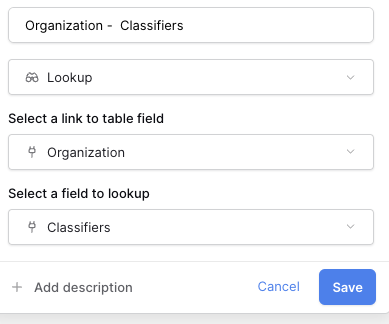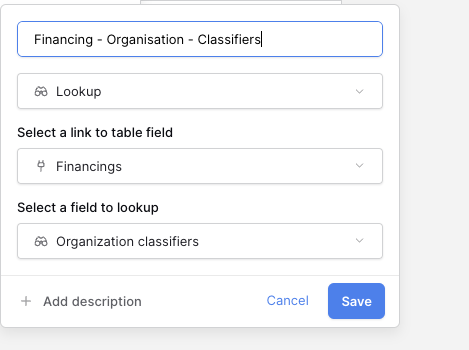Hello @frederikdc I’m posting this here as it’s the same basic question, but with a more complicated twist, but my search led me here.
(Use case: VC and Private Equity)
Because of some end goals in reporting, I have a nuanced set of interrelated data.
4 Tables: Investments, Financings, Organizations, Classifiers
Investments are the investments we make, Financings are about any transaction for which we have good data.
-
The table('Investments') pulls the field('Into-Round') from table('Financings') via Linked field type. This is a “has one” relationship. Example: “Baserow::IPO”
-
The table('Financings') has the field('For-Organization'), Linked field type, and it pulls the primary-ID field from table('Organizations'). Also a “has one” relationship. Example: “Baserow”
-
The table('Organizations') has the field('Has-Classifiers'), Linked field type, which pulls in the primary-ID field from table('Classifiers'). This is a “has many” relationship. Example: “Database App”, “Small Data”, “API-First”, “Default Open-Source”. The table(‘Organizations’) should be the source of truth for the ‘Has-Classifiers’ property.
NOW here’s what I want to do:
In the table('Investments') I want to pull in the field('Has-Classifiers') from the table('Organizations') without needing to duplicate the Organization field in the Investments table, nor do I want a separate Linked field to the Classifiers table. Otherwise it creates an extra data entry burden, and also can create different Has-Classifiers values across different tables.
So, this is either some kind of indirect 3-way lookup, or it could also be achieved with some kind of match function I’m not aware of.
So the query logic would follow something like:
On table('Investments') the field('Into-Financing') linked to table('Financings'), fetch field('For-Organization'), go to the Organization row, and fetch the field('Has-Classifiers').
Example: Our Investment into the Baserow::IPO Financing buys shares in the Organization called Baserow, which has Classifiers of “Database App”, “Small Data”, “API-First”, “Default Open-Source”
And might be a function in Baserow like:
lookup(lookup('Into-Financing', 'For-Organization'), 'Has-Classifiers')
In some kind of ORM it might read:
this.Has-Classifiers = this.Into-Financing.For-Organization.Has-Classifiers
Sorry to be obtuse and also to make such complications.



